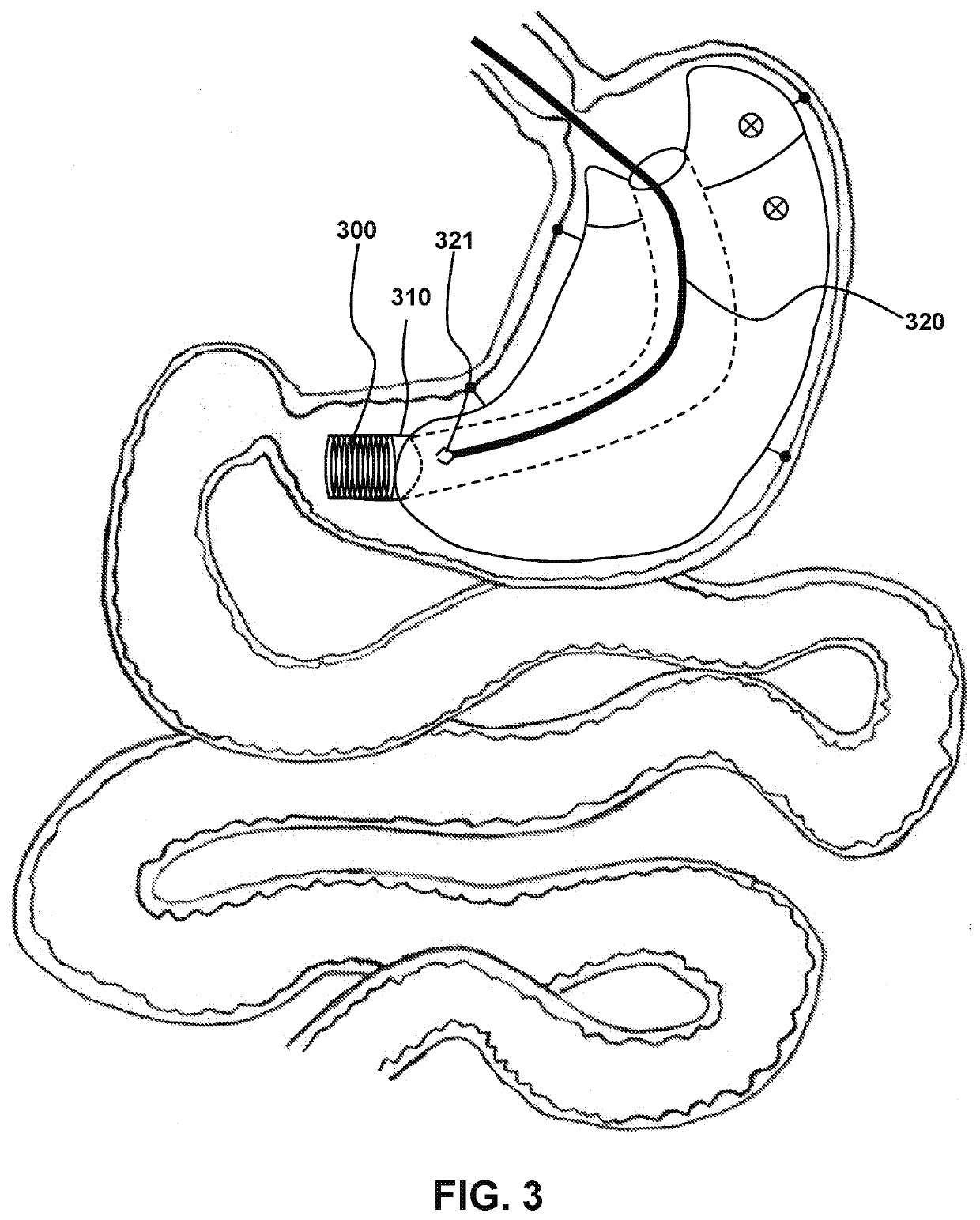Weight Loss Devices Having Anchor-Free Regions
a weight loss device and region technology, applied in the field of weight loss devices having anchor-free regions, to achieve the effect of reducing surgical effort, intervention and requirement for internal anchors, minimally invasive, and convenient deploymen
- Summary
- Abstract
- Description
- Claims
- Application Information
AI Technical Summary
Benefits of technology
Problems solved by technology
Method used
Image
Examples
example 1
CHORABLE GASTRIC BALLOON
[0069]FIG. 1 illustrates a weight loss device for treatment of obesity in a patient formed with a gastric balloon 10 that is positioned in a stomach lumen 20. That gastric balloon has a gastric balloon surface 30 with a proximal end 32 and a distal end 34. Proximal end refers to the portion of the balloon surface that faces toward the esophageal sphincter 50 and the distal end the portion of the balloon surface that faces toward the pyloric sphincter 60. Such a positioning of the distal and proximal ends of the balloon surface aligns a gastric balloon passage 40 that substantially aligns in direction from the esophageal sphincter 50 to the pyloric sphincter 60. “Substantially aligns” in this aspect refers to the functional ability of the passage to direct ingested food 12 that passes the esophagus into the stomach directly toward the pyloric sphincter without substantial blockages or other unwanted obstructions during use. The substantial alignment reflects t...
example 2
D DEPLOYED ELONGATED SLEEVE
[0075]An advantage over the systems provided herein is the ability to easily deploy the system, with fewer surgical manipulations as the design provides a built-in anchoring of the proximal end of the elongated sleeve. FIG. 3 illustrates the device with the elongated sleeve 100 (FIG. 1) in a stored configuration 300. Storage element 310 connected to the gastric balloon surface holds the elongated sleeve in the stored configuration, including in any of a rolled-up or accordion-style folded configuration, such as by a suture that may extend from an internal aspect such as extending from the distal balloon passage, to an external aspect, such as to the distal gastric balloon surface. During insertion, an endoscope 320 may be used to release or remove the storage element, thereby freeing the elongated sleeve distal end from the gastric balloon surface via cutting or removing the storage fastener from the inside aspect of the storage element with a severing mea...
example 3
USTABLE FUNNEL
[0076]To provide an independent control of rate of weight-loss and feeling full or early satiety, the funnel portion of the gastric balloon may be shape-adjustable. Any of a variety of mechanisms may be used to control the shape of the funnel, such as by tensioners or deforming elements. In the illustrated example in FIG. 5A, fluid conduit 232 is connected to funnel fluid port 230 and a fluid introduced to controllably pressurize the funnel portion of the gastric balloon, as indicated by arrow 234 indicating direction of fluid flow. In this manner, the funnel may have a funnel volume defined, in part, by a funnel depth 280 and an average funnel width or diameter 282. FIG. 5A, for example, may correspond to a fully pressurized funnel having a small funnel angle and corresponding larger and well-defined funnel volume, compared to that illustrated in FIG. 5B. Such a relatively larger and well-defined funnel volume increases the amount of ingested food that passes into the...
PUM
 Login to View More
Login to View More Abstract
Description
Claims
Application Information
 Login to View More
Login to View More - R&D
- Intellectual Property
- Life Sciences
- Materials
- Tech Scout
- Unparalleled Data Quality
- Higher Quality Content
- 60% Fewer Hallucinations
Browse by: Latest US Patents, China's latest patents, Technical Efficacy Thesaurus, Application Domain, Technology Topic, Popular Technical Reports.
© 2025 PatSnap. All rights reserved.Legal|Privacy policy|Modern Slavery Act Transparency Statement|Sitemap|About US| Contact US: help@patsnap.com



